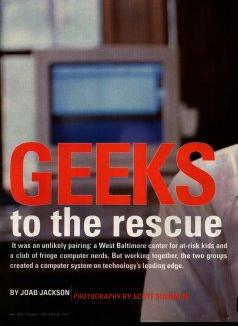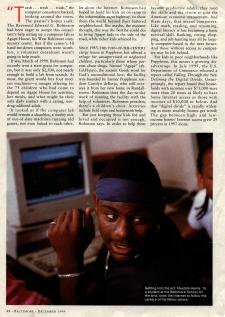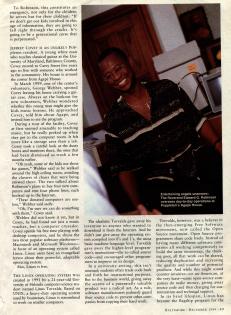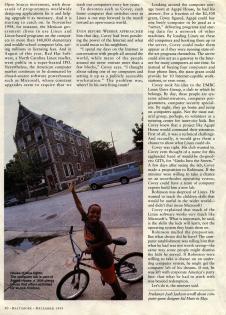
Geeks to the Rescue
It was an unlikely paring: a west Baltimore center for at-risk kids and a club of fringe computer nerds. But working together, the two groups created a computer system on technology's leading edge.
Baltimore magazine, December, 1999

“Trash ... trash ... trash,” the computer consultant barked, looking around the room. The pastor’s hopes sank.
The Reverend Edward G. Robinson had been eager to accept this consultant’s help setting up a computer lab at Agape House, his West Baltimore community center. But if the center’s 10 hand-me-down computers were worthless, a volunteer consultant wasn’t going to help much.
It was March of 1999, Robinson had recently won a state grant for computers, but it was only $2,500, not nearly enough to build a lab from scratch. At most, the grant would buy four modern machines, a meager offering for the 75 children who had come to depend on Agape House for activities, hot meals, and what might be their only daily contact with a caring, non-drug-addicted adult.
It looked as if the computer lab would remain a shambles, a motley mix of out-of-date machines running old games, not even linked to each other, let alone to the Internet. Robinson had hoped to build his kids an on-ramp to the information superhighway, to show them the world beyond their battered neighborhood. But maybe, the minister thought, this was the best he could do: to bring Agape kids to the side of the road, while richer kids whizzed by.
Since 1983, this turn-of-the-century clergy house in Poppleton has offered a refuge for unsupervised or neglected children, particularly those whose parents abuse drugs. Named “Agape” (ah-GAH-pay), the ancient Greek word for God’s unconditional love, the facility was founded by former Poppleton resident Carolyn deBorja, who still oversees it from her new home in Randallstown. Robinson does the day-to-day work of running the facility with the help of volunteers. Robinson preaches; there’s a children’s choir. Activities include field trips and homework help.
But just keeping these kids fed and loved and occupied is not enough, Robinson says. In order to help them become productive adults, they need the skills and the vision to join the American economic mainstream. And these days, that means computers. Like math, reading, and reasoning, digital literacy is fast becoming a basic survival skill. Banking, voting, shopping, and job-hunting may all be largely computer-based in the near future. And those without access to computers may be left behind.
For kids in poor neighborhoods like Poppleton, this means a growing disadvantage. In July 1999, the U.S. Department of Commerce released a report called “Falling Through the Net: Defining the Digital Divide.” Unsurprisingly, the report found that households with incomes over $75,000 were more than 20 times as likely to have home Internet access as those with incomes of $10,000 or below. And that “digital divide” is rapidly widening as more wealthy homes get wired: The gap between high- and low-income homes’ Internet access grew 29 percent in 1997 alone.
To Robinson, this constitutes an emergency, not only for the children he serves but for their children: “If we don’t get our kids involved in this age of information, they are going to fall right through the cracks. It’s going to be a generational curse that is perpetuated.”

Jeffrey Covey is an unlikely Poppleton resident. A young white man who teaches classical guitar at the University of Maryland, Baltimore County, Covey moved to Carey Street five years ago to live with someone who worked in the community. His house is around the corner from Agape House.
In March 1999, one of the center’s volunteers, George Webber, spotted Covey leaving his house carrying a guitar case. Always on the lookout for new volunteers, Webber wondered whether this young man might give the kids music lessons. He approached Covey, told him about Agape, and invited him to see the program.
During a tour of the facility, Covey at first seemed amenable to teaching music, but he really perked up when they got to the computer room. It felt more like a storage area than a lab. Covey took a careful look at the dusty boxes and monitors there, the ones that had been dismissed as trash a few months earlier.
“Oh yeah, some of the kids use those for games,” Webber said as he walked around the high-ceiling room, avoiding the clusters of chairs that were being stowed there. The two talked about Robinson's plans to buy four new computers and rent four phone lines, each hooked up to the Internet.
“These donated computers are useless," Webber said sadly.
“Oh, I’m sure we can do something with them,” Covey said.
Webber did not know it yet, but in Covey, he had found not just a music teacher, but a computer crusader. Covey spends his free time playing with desktop computers, and he shuns the two most popular software platforms Macintosh and Microsoft Windows in favor of an operating system called Linux. Linux users have an evangelical fervor about their powerful, adaptable operating system.
Also, Linux is free.
The Linux operating system was created in 1991 by a 21-year-old University of Helsinki computer-science student named Linus Torvalds. Based on UNIX, a heavy-duty operating system used by businesses, Linux is streamlined to work on smaller computers.
The idealistic Torvalds gave away his invention to anyone who wanted to download it from the Internet. And he didn’t just give away the operating system. Torvalds gave away the higher-level programming instructions, the so-called source code, and encouraged other programmers to improve on its design.
In a university setting, this isn’t unusual. Students often trade code back and forth for instructional purposes. But to the business world, giving away the secrets of a potentially salable product was a radical act. As a rule, software manufacturers jealously guard their source code to prevent other companies from copying their hard work.
Torvalds, however, was a believer in the then-emerging Free Software movement, now called the Open Source movement. Open Source programmers share code freely. Instead of having many different software companies all working competitively to build the same mousetrap, the thinking goes, all that work can be shared, reducing duplication and increasing the quality and number of potential products. And while this might sound counter-intuitive—or un-American--at the very least some open-source companies do make money, giving away source code and then charging for customization and technical support.
In its brief lifespan, Linux has become the flagship program for the Open Source movement, with thousands of programmers worldwide designing applications for it and helping upgrade it as necessary. And it is starting to catch on. In November 1998, for instance, the Mexican government chose to use Linux and Linux-based programs in the computers in more than 140,000 elementary and middle-school computer labs, saving millions in licensing fees. And in August of this year, Red Hat Software, a North Carolina Linux reseller, went public in a super-heated IPO. Nevertheless, the American computer market continues to be dominated by closed-source software powerhouses such as Microsoft, whose constant upgrades seem to require that we trash our computers every few years. To devotees such as Covey, each home computer that switches over to Linux is one step forward in the march toward an open-source world.

Even before Webber approached him that day, Covey had been pondering the power of the Internet and what it could mean to his neighbors.
“I spend my days on the Internet in conversation with people all around the world, while many of the people around me never venture more than a few blocks,” Covey says. “I thought about taking one of my computers and setting it up as a publicly accessible workstation.” The problem was, where? In his own living room?
Looking around the computer storage room at Agape House, he had his answer. For a fraction of the $2,500 grant, Covey figured, Agape could buy one beefy computer to be used as a “server,” delivering programs and storing data for a network of other machines. By loading Linux on these old computers and hooking them up to the server, Covey could make them appear as if they were running state-of-the-art programs themselves. The server could also act as a gateway to the Internet for many computers at one time. So instead of buying four computers and four phone lines, the state grant could provide for 10 Internet-capable work-stations, or even more.
Covey took his idea to the UMBC Linux Users Group, a club to which he belongs. By day, these people are systems administrators, computer programmers, computer security specialists. By night, they go home and jump on computers again. Not the most natural group, perhaps, to volunteer at a tutoring center for inner-city kids. But Covey knew that a project like Agape House would command their attention.
First of all, it was a technical challenge. And secondly, it would give them a chance to show what Linux could do.
Covey was right. His club wanted in. Covey even thought of a name for this eggheaded band of Would-be do-gooders: GITS, for “Geeks Into the Streets,” A few days after seeing the lab, Covey made a proposition to Robinson. If the minister were willing to take a chance on an unorthodox operating system, Covey could have a team of computer experts build him a new lab.
Robinson was skeptical of Linux. He wanted to teach the children skills that would be useful in the wider world and didn’t that mean Microsoft?
Covey explained that much of the Linux software works very much like Microsoft’s. What is important, he said, is the skills the kids will learn, not the operating system they learn them on.
Robinson mulled the proposition. But what choice did he have? The computer establishment was telling him that what he had was not worth saving the same way some people might dismiss the kids he served. If Robinson were willing to take a chance on an underdog computer system, he might get the computer lab of his dreams. If not, he was left with corporate America’s party line: that what he had to work with was beyond redemption.
Let’s do it, the minister said.
It's late in the evening of May 20. A bare bulb burns in what will be the Agape computer lab. A small painting of Jesus looks down on Covey and Phil Gregory, a local system administrator with a mop of shoulder-length hair.
Covey, wearing a faded, lime-green T-shirt, and Gregory, sporting a dress shirt and khaki pants, both sit amidst some equipment donated by other Linux Users Group members--some complete computers as well as boxes full of motherboards. CD-ROM players, and software.
A super-fast dual Celeron processor server has already been ordered. Tonight, Covey and Gregory arc concentrating on getting two of the old computers to communicate with each other. If they can accomplish that, it’ll be simple to hook more computers up to the party line.
Thirteen-year-old Anthony Duncan and another child slip in through the opened door. “Do you have games on it?” Duncan asks, looking at the old, donated computer in front of Covey.
“No, not yet.” Covey replies.
The two kids sit down. and Duncan starts telling his friend about the television show “The PJs.” “You know what my favorite part was?” he asks. “When the junkie invited them over his ‘pad’ and it was a mattress in the alley.” The
kids both squeal with laughter.
At a keyboard, however, Gregory and Covey seem not to notice. Gregory is at one computer, typing with a fluidity of motion one might see in a concert pianist, clacking out long obscure strings of commands with rarely an error-correcting backstroke. Soon, both Covey and Gregory fall into a kind of synchronized computing, with each telling the other what to do next.
The screen of the older computer momentarily flickers on in a burst of color, but then the image breaks apart into a string of error messages.
More typing ensues and finally, the monitor of the old computer, the one previously considered trash, springs to life in glorious full-screen color. Covey calls up an image editor and draws some lines. The system works. Covey lets out a sigh of satisfaction and pushes his glasses back up-the bridge of his nose.
Now comes the fun part: What to name the computers. Each has to have a name, so they can recognize one another. The two men call the two boys over and toss around titles.
“How about Gizmo?” Duncan asks.
“The names should all share a theme,” Covey says.
They all ponder this for a second, and Gregory suggests they be biblical names. This seems like a good idea to the group.
The server is named Eden.
Word of the project went out over the Linux Users Group’s e-mail mailing list, and soon the computer lab was brimming with still more donated equipment. Help arrived, too: Daniel Pearson, president of the UMBC Linux Users Group, frequently came by just to give the kids some supervised time on the computers. UMBC student and campus radio station director Ray Shaw donated about six computers and helped hook them up. Flint Jones, operator of a low-powered (some would say pirate) community radio station stopped by to tweak the code. A security specialist helped with the security issues. About a dozen others stopped by and lent a hand, each bringing his specialized knowledge to bear.
One phone line was installed, and a local Internet provider, Quantum Internet Services, donated a connection. An Agape House Webpage was posted, with room for each child to have his or her own Webpage. Each child also got an e-mail account. By mid-August, the lab had six computers up and running.
The GITS team did experience set-backs. When big rains came in early September, Covey found that Agape wasn’t quite seaworthy. Water poured in through the roof and down one side of the computer room. “Now I know why a few computers have rust on them, Covey quipped. The computers that were salvageable were moved over to the other side of the room.
And then there was another potentially destructive force of nature: teenage curiosity. Shortly after the lab opened in mid-August, Covey found evidence that an unauthorized user had entered the lab and crashed the server. A few days later, he checked the computer-room logs and found that children were using the lab during periods when it was supposedly closed.
Such unauthorized use is dangerous not only to the computers, but to the children, says Covey, who once had to stop one of the children from giving his home address to a stranger in a chat room.
Now the lab is officially open between 4 and 7 p.m. weekdays and varying weekend hours, as long as an adult is available to supervise. Some of the UMBC Linux Users Group have volunteered, but this is an ongoing challenge in his ministry, Robinson says: “People would much rather write a check than come down for three or four hours.”
In early September, Covey sent an e-mail to others on the UMBC Linux Users Group list about his work with Agape. “More and more, I think the biggest problem facing poor neighbor hoods is lack of imagination,” he wrote. “If you can’t imagine a better life, you don’t go for it. You just sit and wait for whatever happens to happen.”
Covey told of talking to his next door neighbor, a heroin addict about getting a high-school equivalency certificate. The Learning Bank, a non-profit that helps adults study for the test, was just a few blocks away. “He said he’d never heard of it,” Covey wrote. “It’s got letters on the front four feet high screaming ‘The Learning Bank’ but it didn’t register with him because it wasn’t a part of his routine." This man could not make a plan to improve his life, because hopelessness blinded him to the possibilities.
The resources for change are present in Poppleton, Covey wrote, but they go unused. “If you look at a lot filled with garbage and you can’t imagine it being any better, you don’t clean it up and you don’t stop people from dumping in it.”
Still, Covey remains optimistic. He is looking at other projects for GITS, such as volunteering to help some Pratt branch libraries with their networks. “A computer hooked to the Internet can be a good source of imagination, and a contact to a world where people prize knowledge and education and hope and having a plan,” he says.

As for the Agape kids themselves, there is no debate--they love the lab. Whenever the door is unlocked, they rush in to e-mail friends, work on school assignments, and surf the Web. Sixteen-year-old Mustafa Harris, for instance started out visiting the lab almost every day, though he admits he’s down to about once a week since taking a job at a nearby Superfresh. The lanky youth studies acting at the Baltimore School for the Arts, and he comes alive when explaining how he uses the Internet to keep tabs on role models such as Denzel Washington and Wesley Snipes. “I always look up to see how other actors are doing in the industry,” he says.
Harris recently received a school assignment to find a piece of art that he could relate to, and he found it on the Web: a tribute page to rapper and actor Tupac Shakur. The site depicted a rose growing through the crack in a slab of concrete. Harris saw at once what it represented, he says: “If you see a rose, no matter how dirty the surrounding is, you’re going to look at that rose and be amazed that it came out of the concrete.
“That really touched me,” he adds. “If Tupac is that rose that can come out of the concrete and make it, anybody can.”
Although a lot of homework is done at the lab, so is a lot of Web surfing and game playing. The GITS volunteers aren’t worried, though.
“Just getting experience at the computer is important,” says Ray Shaw, 22, the UMBC student who watches the lab every Thursday. “It’s like reading Stephen King novels. It may not be as instructional as reading a math book, but you do pick up reading skills.”
Witness Anthony Duncan. With no other computer experience, Duncan has already shown an uncanny intuition for dealing with Linux and its programs. This came as no surprise to the GITS team, who were used to him hanging around and watching them work before the lab was open. “When they were hooking up the computers, I was the first one to get logged on,” he boasts.
Once on-line, Duncan quickly learned how to download and print pictures of castles, mopeds, and dream cars. (A $90,000 Mercedes-Benz coupe is a favorite of his.) He took to e-mail immediately. When school started, he used the computers to write reports, handing in assignments that were neater than the hand-written pages he used to submit. He also started playing chess over the Internet.
Learning to do all this has given Duncan a feel for Linux. He has learned how to shut down troublesome programs and honor the operating system's quirky case-sensitivity In fact, Duncan has’ quickly taken on the role of lab assistant. Most of the questions that fellow Agape children have about Netscape and e-mail are now answered by Duncan. "These are marketable skills,” says Ray Shaw.
With no computer at home and very limited access to one at school, who knew that Duncan had this talent? One can’t help but wonder how many others like him are out there, ready to be plugged in.
What does the world stand to gain by saving what others have thrown away? GITS and the Agape House are starting to find out.
--Joab Jackson